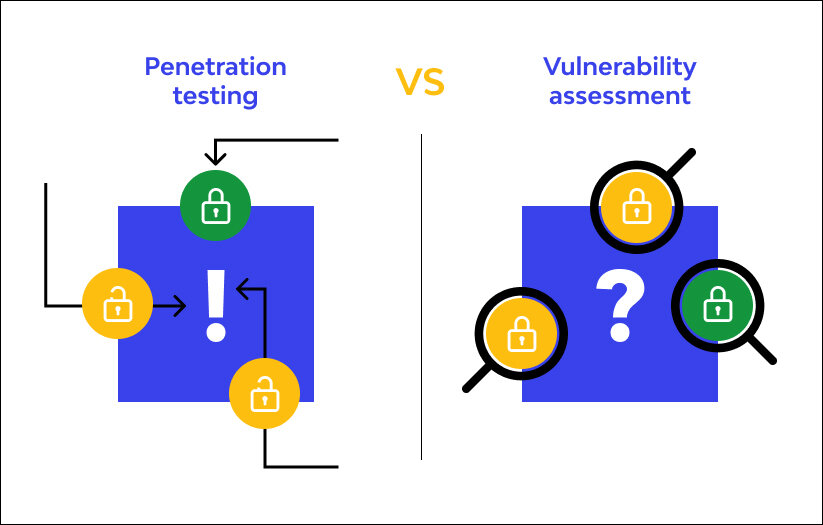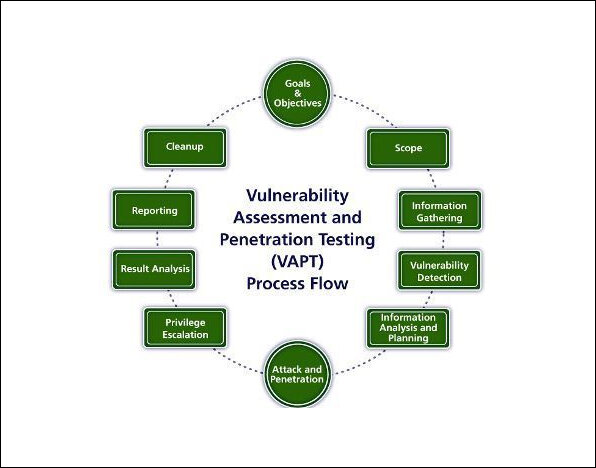Moderation and regular use of VA and PT jointly are the safest ways to proceed. This double-barreled approach guarantees constant monitoring and testing.
Try to picture your company as a mediaeval fortress. You have vigilant guards (virus protection) and strong walls (firewall), both of which are necessary but not flawless. What if there is a crack in the wall or a door that the guards don’t know about? Penetration testing and vulnerability assessment are useful in this situation. They are like fortress builders and spies – they work together to make your digital fortress impenetrable.
In today’s digital age, cyberattacks resemble today’s version of the siege warfare. Every day, small businesses, large organizations and companies around the world lose huge amounts of money and damage their image through data theft. So it’s important to know the difference between vulnerability assessment and penetration testing to protect the overall security of your digital empire.
Let’s understand the basics
What is Vulnerability Assessment?
Vulnerability assessment is a method of identifying and evaluating security risks in information systems. It determines whether the system is prone to any of the identified vulnerabilities, classifies the severity of such vulnerabilities, and identifies appropriate measures to address these vulnerabilities when and if necessary.
Key Features of Vulnerability Assessment:
- Broad Scope: VA begins running checks through the system searching for any predefined vulnerabilities.
- Automated Tools: Includes automated scripts for fragile segmentation.
- Risk Prioritization: Facilitates the identification of risks based on their potential consequences.
- Regular scanning: If possible, it should include periodic updates and updates on new vulnerabilities.
What is Penetration Testing?
Penetration testing is commonly known as Pen testing or Ethical hacking, in which an authorized person tests the security of an organization’s information system by emulating an attack. Its primary purposes. The primary is to advise security administrators and managers about risks to an organization to help them assess the consequences of an attack and check whether existing security measures are sufficient.
Key Features of Penetration Testing:
- Simulated Attack: In penetration testing, the organization mimics an attack by actual attackers through the use of identical tools and techniques. This realistic approach aids in discovering weaknesses that may not be found using solely automated systems, which makes it an actual determination of an organization’s security.
- Manual and Automated Testing: Penetration testing is a combination of automated scanner tools and hands-on pen testing. Furthermore, automated tools often identify common vulnerabilities, whereas, hands-on testing allows a tester to think outside the box, combine attacks, and identify nuanced issues.
- Detailed Reporting and Impact Analysis: A penetration test entails generating elaborate reports that not only enumerate discovered vulnerabilities but also describe the consequences of the exposure of each hole. Organizations can use this analysis to rank remedial activities according to the seriousness of the threats found.
- Regulatory Compliance: To adhere to regulations like PCI DSS, HIPAA, and GDPR, penetration testing is a must for many companies. Penetration testing ensures that organizations meet these compliance requirements by validating the effectiveness of their security controls against real-world threats.

Vulnerability Assessment vs. Penetration Testing: Main dissimilarities
To make the right choice, it is necessary to identify key distinctions between these two strategies.
1. Objective
- Vulnerability Assessment: Assesses potential threats in the system and categorizes risks.
- Penetration Testing: Takes advantage of these weaknesses to determine actual consequences and probable outcomes.
2. Methodology
- Vulnerability Assessment: Fully depends on automated features for scanning and detection of threats and weak points.
- Penetration testing: Manual inspection and creative approaches to goals based on identified defects.
- Vulnerability Assessment: Fully depends on automated features for scanning and detection of threats and weak points.
- Penetration testing: Manual inspection and creative approaches to goals based on identified defects.
3. Frequency
- Vulnerability Assessment: Sometimes conducted routinely to capture recently discovered vulnerabilities.
- Penetration Testing: Usually, this should be done at least once or twice a year, or after making revisions in the system.
4. Outcome
- Vulnerability Assessment: Provides a list of issues together with the risks that are related to them.
- Penetration Testing: Offers detailed reports with descriptions of attacks and countermeasures.

Choosing the Right Strategy in 2024
When it comes to choosing between Vulnerability Assessment and Penetration Testing, consider the following factors.
1. Security Maturity
- For Newer Systems: If your system is fairly new and has not been stress tested prior to the vulnerability assessment, then do a vulnerability assessment and rectify known vulnerabilities.
- For Mature Systems: Penetration testing focuses more on detrimental risks if your integrated system has seen multiple VAs.
2. Compliance Requirements
- Regulatory Standards: Some sectors have regulations governing how frequently they can use VA or PT. For instance, PCI DSS standards require companies to perform penetration testing at least once a year.
3. Resource Availability
- Time and Budget: Studies have shown that VA is faster and less expensive than PT. First, if budget constraints are tight, go for a VA.
4. Risk Tolerance
- High-Risk Environments: In cases where your establishment is in an industry with increased susceptibility to litigation (for instance, finance or healthcare), VA should be implemented in conjunction with PT.
Conclusion
One of the key strategic choices that will determine the security of your company in 2024 is whether to use PT or VA. While PT excels in playing an intelligence spy that finds gaps in the defenses of a computer system, VA serves the role of constructing your digital fortress and consistently searches for cracks to fix.
In my view, moderation and regular use of VA and PT jointly are the safest ways to proceed. This double-barreled approach guarantees constant monitoring and testing and also substantiates your protection measures with occasional but realistic testing. The question is not longer between which to choose the two, but rather how both can be put into practice in a way where your digital structure is invulnerable to hacks.
In case you missed:
- Top 5 Cybersecurity Trends in 2024: Protect Your Business Now
- Forecasting the Future: Generative AI in Software Testing for 2024
- Kickstarting your MLOps journey in 2024: Essential practices and strategies
- Identifying the Best Development Tunnelling Tool: Ngrok vs. Localtunnel
- Hybrid and Multi-Cloud technologies in 2024: Developments, challenges, and Innovations
- What’s new in Azure app service at Build 2024: Key announcements and features
- Blackwell chip: Nvidia engine for breakthrough AI
- GPT-2 Chatbot Mystery: Outperforming GPT-4 or Next-Gen AI?
- Deciphering RHEL AI: An Open Source Approach to Artificial Intelligence
- Unleashing the Power of Voice: Exploring Meta Voicebox AI









